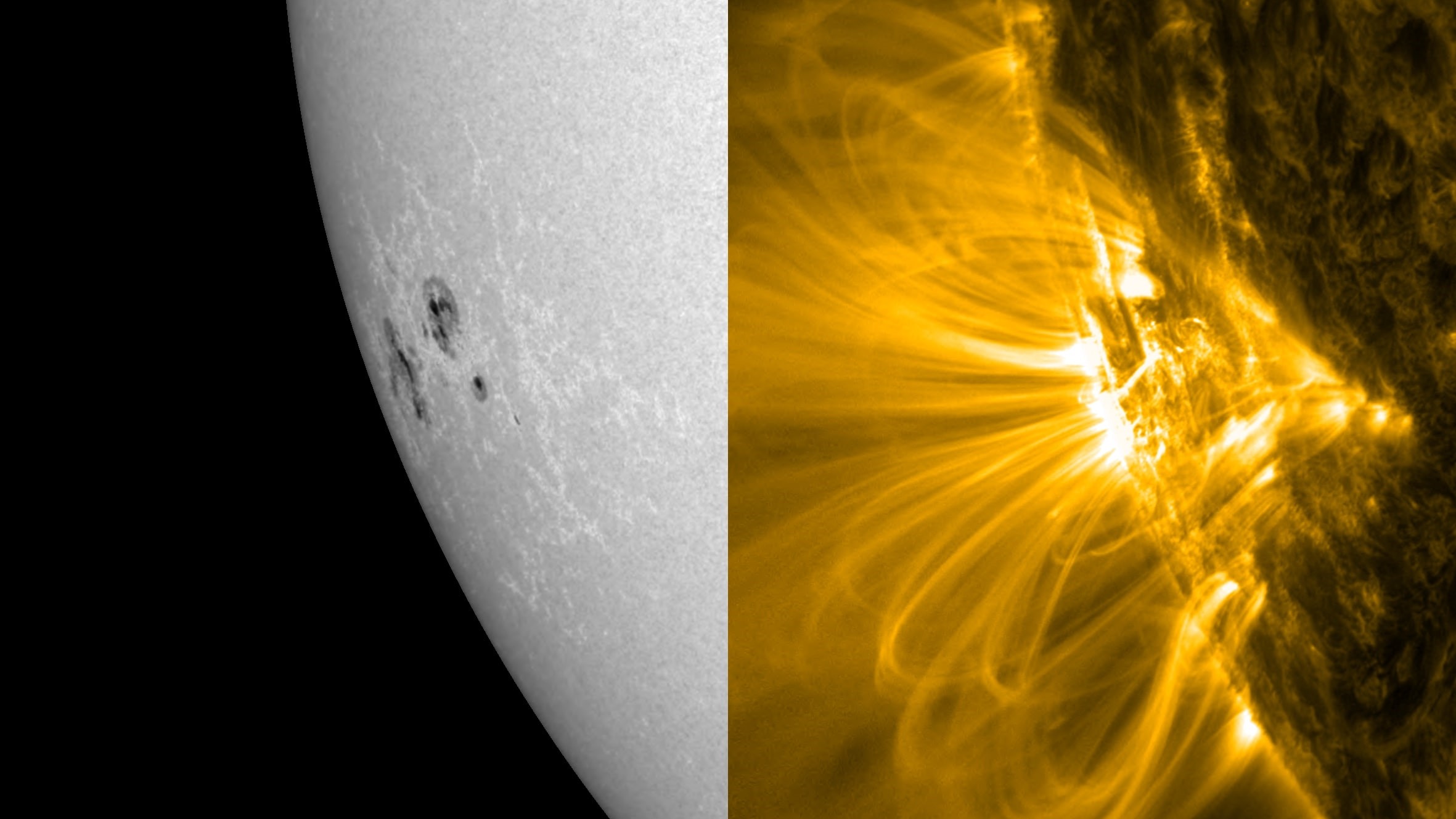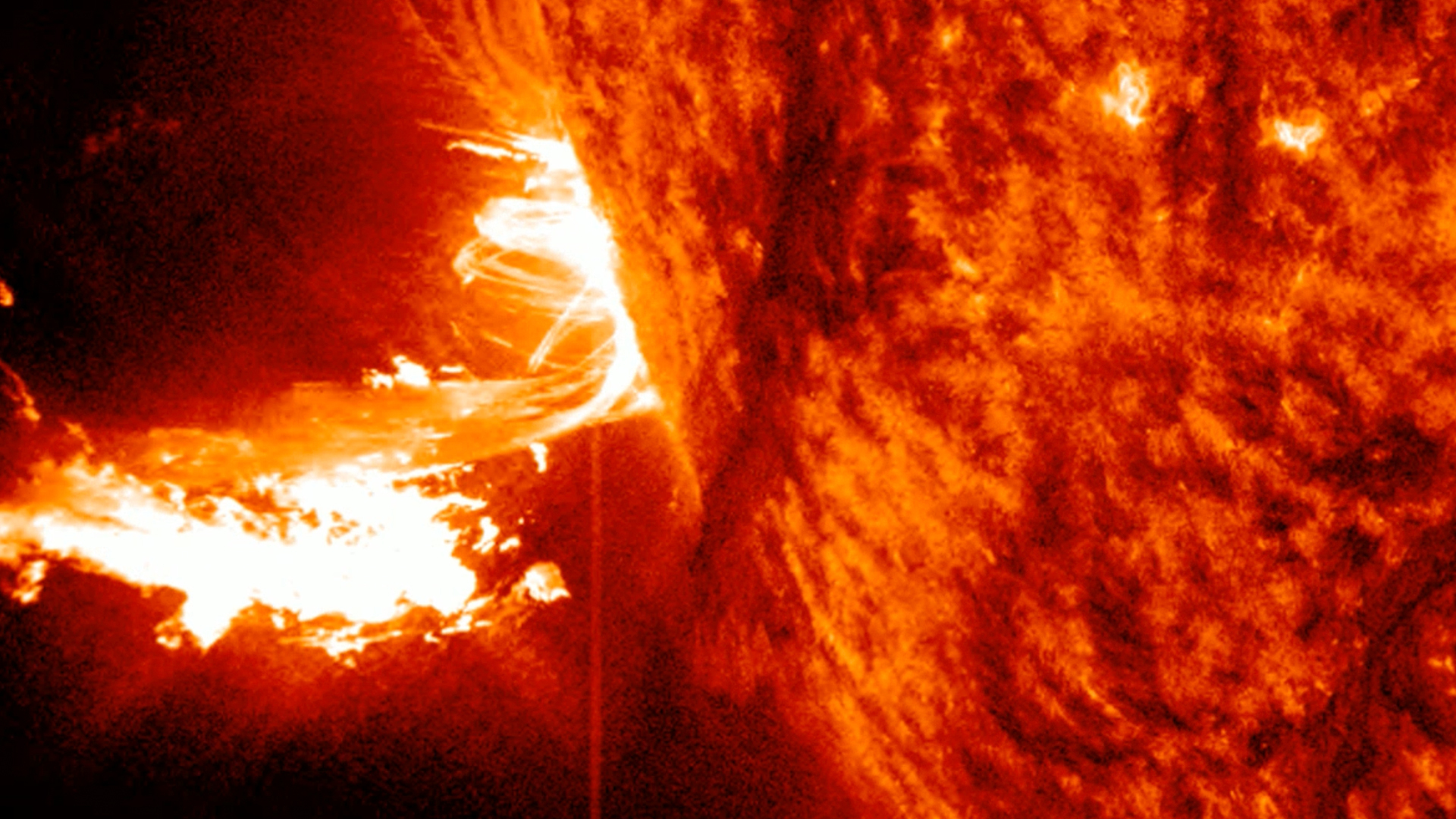
Earlier this month, solar active region AR 13664 produced 12 X-class solar flares across six days.
The first batch of flares triggered successive Earth-directed coronal mass ejections (CMEs) — large expulsions of plasma and magnetic field from the sun — resulting in a G5 geomagnetic storm at Earth.
This category of geomagnetic storm, the first since 2003, caused widespread auroras around the world. On May 14, on its final day before rotating behind the western edge of the sun, the active region produced the largest solar flare since September 2017 — clocking in at an X8.79-class.
Two weeks later, the active region has reappeared on the eastern edge of the sun. Now that it's back — what solar activity can we expect in the coming weeks?
Related: Colossal X-class solar flare suggests return of sunspot group that fueled May's epic auroras (video)
The sun has an average rotation period of 27 days, providing Earth with a view of a given active region for around two weeks before it rotates over the sun's western edge. Due to a historical inability to track an active region around the back of the sun, newly visible active regions rotating onto the sun's eastern edge are given a new active region number. Therefore, with its new arrival back into view, AR 13664 has been renamed AR 13697.
However, in this case, AR 13664 / 13697 was never hidden from view, due to continuous X-ray observations from the European Space Agency's Solar Orbiter spacecraft, which is currently sitting behind the sun (from our perspective) for the next few months. During its transit across the sun's backside, the active region slowed down somewhat with the overall frequency of X-class flares dropping dramatically. But with its reappearance, we can begin to assess whether this quieter trend is set to continue.
The first hint of AR 13697's sunspots came into view late on May 27, with the full region visible end of May 28. Making an entrance worthy of its earlier reputation, the active region produced an X2.9 solar flare. Despite triggering fewer large flares from the sun's backside, Monday's X-class solar flare asserts that the region is still capable of producing these more noteworthy events.

The active region will continue to rotate across the sun over the next two weeks, providing a view of any solar flares from the region during this window. The light from any solar flares in this window will reach Earth, with the potential to produce short-term radio blackouts. These are temporary disruptions to radio-wave propagation on the sun-facing side of Earth, lasting only an hour or so.
As we experienced in mid-May 2024, some flares may also trigger the eruption of a CME. Unlike flares, CMEs are directional, and their potential impact on Earth relies heavily on the location of its source on the sun. For a CME to have the best odds of reaching Earth, it would need to erupt from the slight right of the sun's center. AR 13697 will reach this location of optimum Earth connection around June 4-6, around one full solar rotation (27 days) since the mid-May solar flares. Eruptions close to this window will have the best odds of producing a geomagnetic storm and enhanced aurora display here on Earth.
After producing fewer X-class flares around the back of Sun, old active region AR 13664 is finally back with a bang - producing an X3-class #SolarFlare this morning! All solar observatories are watching for whatever this region does next. #spaceweather #astronomy pic.twitter.com/j9xOhHkULsMay 28, 2024
With fewer X-class flares coming from AR 13697 than in its previous rotation, does this decrease our odds of another strong auroral display? Somewhat, but it is more complicated than that.
The May 2024 geomagnetic storm was so strong due to the subsequent impact of multiple CMEs in quick succession. If their arrival were isolated from one another, the impact of each individual CME would have been less noteworthy. If the current trend of fewer X-class solar flares continues, a similar bombardment by multiple eruptions is less likely. However, with optimum conditions, only one flare is needed to produce the sufficiently dense, fast, and perfectly positioned/oriented CME needed to repeat a similar geomagnetic storm.

As AR 13697 rotates further into view, we'll have a better idea of its flaring odds. The magnetic field is the primary driver of solar flares, and the more magnetically complex an active region, the higher the likelihood of strong flares.
The NASA Solar Dynamics Observatory and National Science Foundation's Global Oscillation Networks Group will both measure the magnetic field of the active region but struggle to do so whilst so close to the sun's edge. Within the next 1-2 days, as the sunspot region rotates further into view, we'll get a new assessment of the region's magnetic complexity and flare likelihood.
The May 2024 aurora event was truly a rare occurrence, as the first G5 geomagnetic storm since 2003. Even if high activity continues from AR 13697, the perfect alignment of conditions needed to reach a G5 level will be tough to repeat again. Although a G5 is not likely (but not impossible) to happen again this month, G3-4 conditions would still provide a view of the aurora to millions at higher latitudes.
This is also not our last chance. As solar activity continues to rise to its expected peak in late 2024-2025, we can look forward to many more strong geomagnetic storms. Although another G5 storm is not guaranteed during this solar maximum, it's certainly possible.







